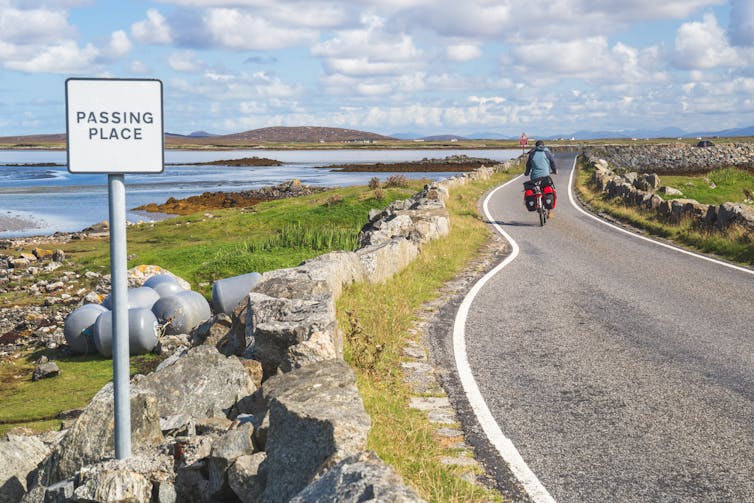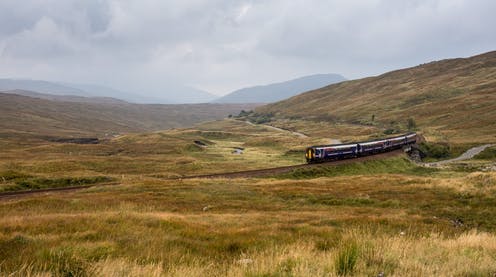We are now approaching a full year of living with COVID-19 and the restrictive conditions of lockdown. Its impact on travel networks, particularly public transport, has prompted plenty of discussion, but much of the emphasis has been on cities, with less attention given to the countryside – the island and rural areas where travel was already a challenge.
People’s travel needs have evolved in response to COVID-19, with the rise in home working, concerns around conventional public transport and interest in relocating from cities to rural and island areas. So despite the challenges, there is not only an opportunity but a demand for a new way to travel in rural areas which better considers the needs of local communities.
My research looks at something called “mobility as a service”, which combines all manner of transport to help people get from A to B. Traditionally, pilot projects focus on city areas using an app, but technology is not always the answer and the needs and characteristics of rural communities differ from urban areas. My work focuses on local communities so we can identify barriers to mobility and design transport options that improve access to health, education and employment.
Pandemic challenges
Beyond the private car, country dwellers have always lacked choice when it comes to getting around for daily life. Options are often limited to sporadic bus services (already facing serious cuts before the pandemic, community transport or catching a lift with a friend or neighbour. But crucially, these forms of transport have also offered the extra value of social interaction for the most vulnerable or isolated in rural communities.
Throughout the pandemic these services have been affected by further timetable restrictions and limited passenger numbers to comply with social distancing. Not only is car sharing discouraged due to safety risks, but there are also concerns about travel on public transport.
While cities are also feeling the effects of decline in public transport, the wider effects are exacerbated in rural areas. Here, residents cannot always safely substitute walking or cycling due to distance or lack of pavements, street lighting and cycle lanes. This, in turn, has had a knock-on effect for communities, businesses and healthcare.
For example, how do people access a distant vaccine centre if cars and public transport are not available? A recent story in the Financial Times described “vaccine deserts” in England, highlighting that 5.5 million people are more than an hour by public transport away from a centre.

Arthur Campbell/Shutterstock
Mind the gap
Lack of choice and gaps in transport infrastructure are also worsened by the dearth of digital connectivity in some areas, which is important for accessing mobile apps, online ticketing and transport information and tracking.
Many rural areas have poor mobile phone and internet coverage, both of which have caused problems for many under lockdown. The increase in home schooling and working from home has not only highlighted these issues but increased the expectation of good service and access for rural or island communities. This has been compounded by the increase in demand for property in the country.
Traditionally, rural-to-urban commutes are longer, a trade-off that many are willing to make for lower housing costs and the benefits of living in the country. But in the last six months, there has been a boom in rural property, particularly in the Highlands of Scotland and the south west of England. This trend brings additional expectations and pressures on digital connectivity and transport.
But these complications have also provided scope for more innovative thinking in terms of improving accessibility, rather than transport, in rural areas. Before the pandemic, rural areas were witnessing the decline of banks and post offices and an increase in vacant buildings. But the last 12 months have seen a shift towards supporting people in their own communities. Local shops and food outlets, businesses and online retail have introduced and increased deliveries to rural areas.
This shift in bringing services to people highlights the need to adapt if rural businesses are to survive. Making habit and lifestyle changes, has also been an important change among rural residents, including more walking and cycling locally.

EyesTravelling/Shutterstock
Unfortunately, this also highlights the dangers of country roads that are ill-equipped or designed to deal with increasing numbers of cyclists and walkers. As a consequence of COVID-19, residents, business, local councils and transport agencies have all been propelled to work together to find solutions. Historically this kind of partnership working has been difficult due to the traditional nature of “silo working” where groups tend to work discretely without collaboration. But this pandemic has made such collaboration a necessity and is one positive legacy from a hard year.
Trying fresh ideas and innovations is not new to rural areas, such as the use of drones for transporting blood samples, but the community landscape in rural and island areas is changing. This week saw drones again being used to deliver COVID samples from remote areas in Argyll and Bute.
These those living and working in rural areas, these unique needs must now be properly addressed, whether that’s a decent wi-fi signal for home schooling and working, more flexible transport options or simply just changing what wasn’t working before.
This pandemic provides the ideal opportunity to address the lack, disparity and inequality that rural communities have always faced. In Scotland the National Transport Strategy released in February 2020 states it will:
ensure those living in rural, remote or island communities will be well connected and have as equitable access to services as those living in the rest of the country, therefore making a positive contribution to maintaining and growing the populations in these areas.
Local, regional and national governments will need to be open to serious change for this to happen.
![]()
Jenny Milne is affiliated with Chartered Institute of Logistics and Transport (CILT) and the Scottish Rural and Islands Transport Community (SRITC). Her part time PhD is part funded by the Energy Technology Partnership (ETP) and the Scottish Regional Transport Partnership (RTP) HiTRANS.











